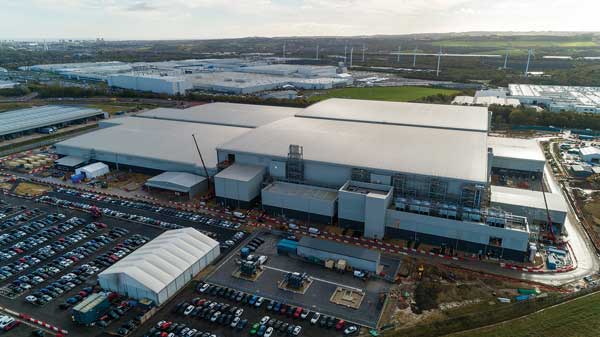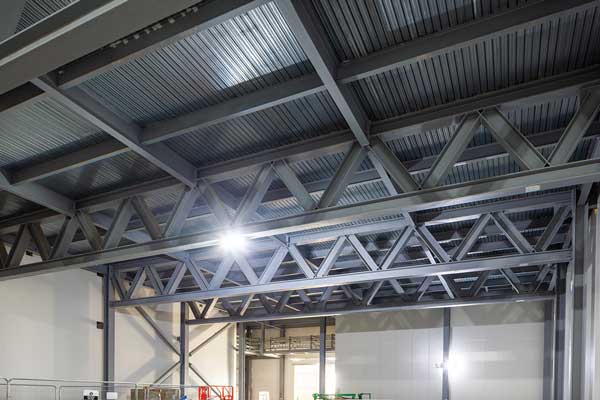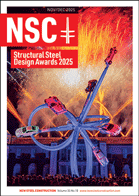SSDA Awards
AWARD – AESC UK, Sunderland
New benchmarks in modular and efficient steelwork construction were set during the delivery of a large gigafactory in Sunderland.
FACT FILE
Architect and consultant engineer: Tetra Tech | RPS Group
Structural engineer and steelwork contractor: Severfield plc
Main contractor: Wates Construction
Client: AESC UK
Delivering a six-fold increase in UK electric vehicle battery production, AESC UK’s Sunderland gigafactory is housed within a huge steel frame covering an area equivalent to 23 football pitches.
The project forms part of a wider £1 billion partnership between Nissan and Sunderland City Council to create an electric vehicle hub, envisaged as the world’s first EV manufacturing ecosystem.
Set to employ more than 1,000 staff, the factory will utilise 100% carbon neutral energy, aligning with AESC UK’s global sustainability commitments.
Working on behalf of main contractor Wates Construction, Severfield fabricated, supplied and erected a significant tonnage of both hot-rolled and cold-rolled steelwork for the main frame and its associated structures.
According to Wates, the race to deliver the UK’s first gigafactory, meant there was no blueprint for this project. “We needed a partner of choice, and Severfield stepped in.”
The challenges around a facility of this nature included a client who needed to procure materials as late as possible, in order to incorporate the latest technologies.
“Structural steel gave the client the necessary platform to undertake the required changes due to the flexibility of the material, which could not have been achieved with other materials,” says Severfield Project Manager James Massheder.
“Due to the nature of the project and the ever-changing technology required in battery manufacture, our main challenge was managing and incorporating the constant changes from both the process design and the related mechanical, electrical and plumbing (MEP).”
With around 14,000km of mains cabling within the building, the installation of the MEP was initially going to require a major installation programme.
However, an innovative approach was used, whereby 1,600 steel frames were manufactured offsite, fitted with the required MEP and then delivered to the project to be installed along with the main frame’s steelwork.
A first in Wates’ experience, this offsite prefabrication approach is said to have eliminated over 500,000 hours of working at height from the project.
Spanning the majority of the steel-framed facility and creating the required column-free spaces, the building includes a series of large fabricated roof trusses, which are supported by perimeter columns with flange thicknesses exceeding 90mm.
The steel frame also supports manufacturing equipment that creates substantial imposed loads. During the design phase, this required meticulous planning and robust structural solutions to the steelwork.
Additionally, stringent deflection limits were imposed on the project’s long span floor beams, in order to uphold the structural integrity and the required performance standards.
Other steelwork design challenges that had to be overcome, included the limited availability of locations for vertical bracing. This was solved with an innovative engineering solution that maintained stability, both during construction and in the completed building.
According to project architect RPS Group, another challenging aspect of the job was associated with the various aspects that form the fire strategy.
Particular attention had to be taken with the different compartments within the building (many of which are sterile or clean environments) and the services which pass between them.
To satisfy the fire strategy, fine detailing was required around the building’s expansion joint. This was due to the amount of movement it needs to accommodate and because of its proximity to the building’s transition point between the multi-storey and the single-storey areas.
Fire engineering was another critical consideration, involving the careful selection of steel member sizes and the application of intumescent paint, to meet rigorous fire rating requirements, while ensuring structural safety and operational functionality.
In order to maintain an efficient programme, the steelwork was delivered on a just-in-time basis, which avoided congestion and ensured safe onsite working practices were maintained. Up to 50 truckloads of steel were delivered to site each week.
Initially, the steelwork was transported from Severfield’s factory at Thirsk in North Yorkshire, nearly 200 miles from the site. To cut journey times, a temporary assembly facility was established at Pallion shipyard in Sunderland, which saved the project approximately 38 million grams of CO₂.
Business and Trade Secretary, Jonathan Reynolds, says: “We’re backing our world-class car industry, and this project is yet another vote of confidence in the North East’s thriving auto manufacturing hub, which will secure a thousand well-paid jobs and boost prosperity across the region.”
Shoichi Matsumoto, CEO of Japanese headquartered AESC, adds: “This investment marks a key milestone in AESC’s ongoing efforts to support the UK’s path towards decarbonisation and the expansion of its EV market.
“Through close collaboration with strategic partners, we strive to accelerate this transition while creating high-quality local jobs and building a resilient, sustainable supply chain. We are honoured to contribute to the development of low-carbon economy with our advanced battery technologies.”
Supporting the client’s sustainability aspirations, a key feature of the project was its approach to water management. A significant attenuation system was integrated beneath the site’s car park, which mitigates flood risk and supports sustainable water use. The system has a huge capacity and is capable of storing enough rainwater to fill five Olympic-sized swimming pools.
Summing up, the judges say, this ambitious and nationally significant project hosts AESC’s cutting-edge production facility. Covering a huge area and with battery production technology evolving even as the building was being erected, the whole project team responded to the challenge with impressive speed and flexibility.





